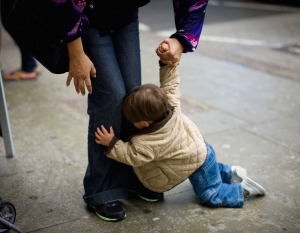How we love to talk! We especially love to talk to our children. But, what are we saying? And what are our children hearing?
Lots of Talk
We’ve heard the embarrassed parent in the supermarket threaten to leave the screaming child at the store, or never to bring her again. Or, worse yet, after arguing and refusing to buy some item at the checkout, the parent yields to the pressure of the tantrum and buys the pack of gum anyway.

Meanwhile we talk and talk and talk, but what our children hear is the tone of our voice.
They certainly do not pay attention to our words because our words rarely go along with our actions. We say “No” over and over, but eventually we say “Yes.” We threaten certain actions but, fortunately for our child, don’t deliver. We make promises but fail to keep them.
A Not-So-Good Example
Let’s try an example. You’ve been at the park for an hour. It is time to go home and get dinner started. You call, “Suzie, it’s time to go home.” You get no response. So you figure she didn’t hear you. You call to her again. Still no response. Now your voice rises a little. “It’s time to go,” you say more forcefully. Perhaps this time you get a response, but it’s not the one you hoped for. She doesn’t want to leave. What do you do? “Okay,” you say, “5 more minutes,” but you know in your heart that 5 more minutes will just lead to 5 more, and then 5 more and, eventually a fight.
we talk and talk and talk, but what our children hear is the tone of our voice
So, you offer an ice cream at Baskin & Robbins; you promise to come back tomorrow; you threaten to go home without her; you inform her that you’re going to tell daddy, etc., etc. You both are worn out from the struggle, you’re late getting home, and a nice afternoon at the park ends on a very unpleasant note.
A Better Example
Here’s another way it might go. At about 5 minutes before you plan to leave, you tell Suzie it’s almost time to go and that she has 5 minutes to get a last turn on the slide or the swing. Then at the end of 5 minutes, you gather your things and tell Suzie it’s time. If Suzie balks, you stop talking and take action. You ask her if she would like to walk to the car or be carried.
Young children are desperate for that security.
If her response is to stay at the park (which was not one of her choices) you walk over, pick her up without speaking and go directly to the car. Put her in, even if she is screaming and crying, and drive home without a word.
Why Intentional Parenting Matters
This result leaves you calm, gets you home on time, and gives “Suzie” the message that she does not have the power to decide on everything. You’ve given her a clear message that she can depend on your words – that you say what you mean and that she can believe you. Young children are desperate for that security. Also, by giving her that 5 minute notice before it was actually time to go, you showed respect for her timetable.

When the crying stops (and it does, if you ignore it) be sure to engage her in conversation about something other than the scene at the park. Ask for her help with dinner preparations, or feeding the dog. Children will not persist with behavior that is not rewarded.
So, be prepared to act the next time a conflict like this is on the horizon. Otherwise, what your child will really hear is “Blah, blah, blah, Ginger.”



Leave a Comment